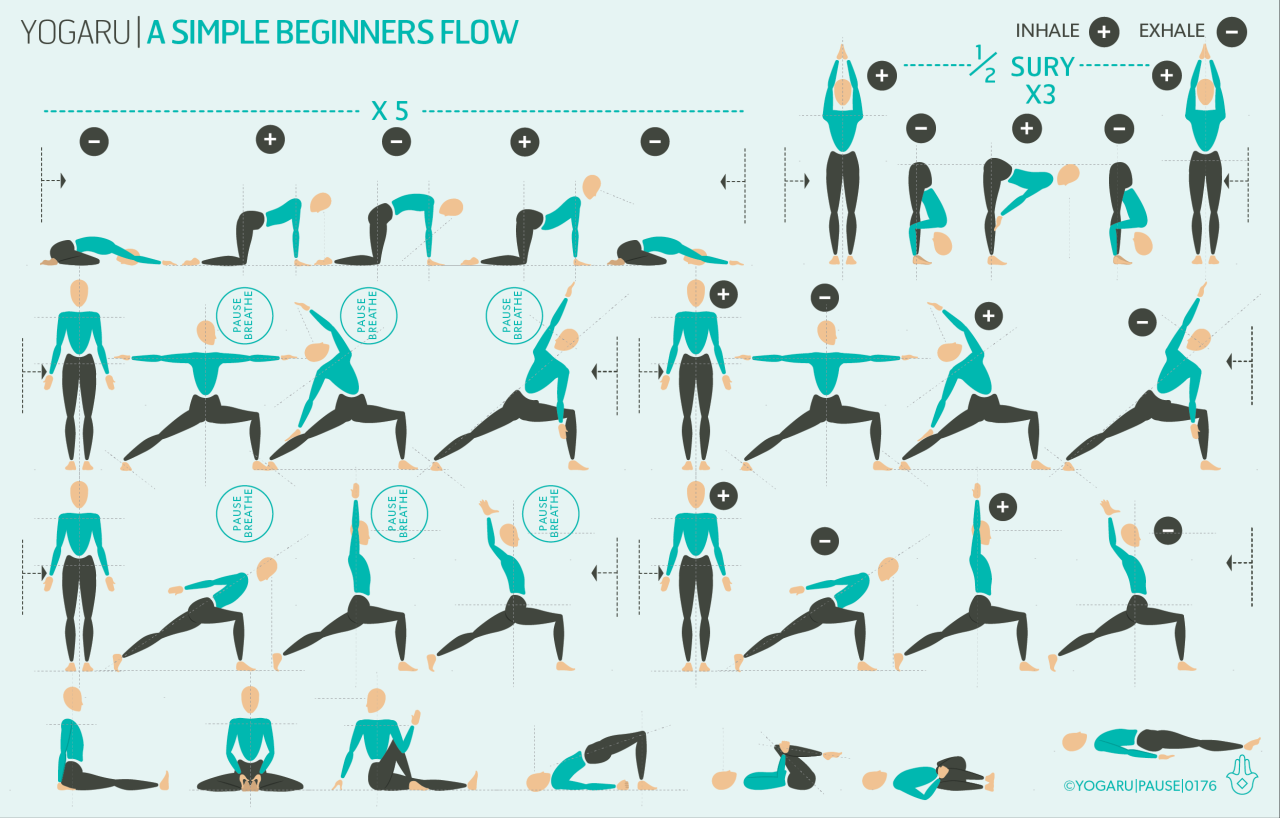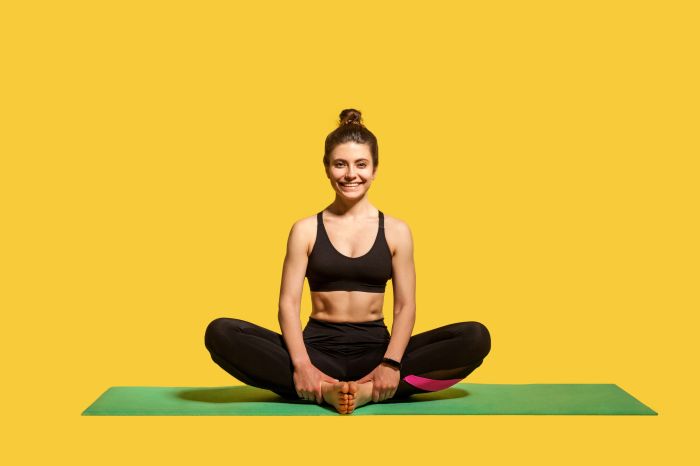Yoga for Beginners introduces a whole new world of wellness and self-discovery, perfect for those looking to kickstart their journey into the practice. Get ready to dive into the basics with a twist of cool vibes and easy-to-follow guidance.
From debunking myths to mastering essential poses, this guide is your ticket to a zen-filled lifestyle. So, grab your mat, take a deep breath, and let’s flow into the beginner’s realm of yoga.
Introduction to Yoga for Beginners

Starting yoga as a beginner can be a game-changer for your physical and mental well-being. The benefits are endless, from increased flexibility and strength to stress relief and improved focus. It’s a holistic practice that can transform your life in more ways than one.
Benefits of Yoga for Beginners
- Improves flexibility and balance
- Builds strength in muscles and joints
- Reduces stress and promotes relaxation
- Enhances mental clarity and focus
Importance of Starting a Yoga Practice for Beginners
Starting a yoga practice as a beginner sets a strong foundation for a healthy lifestyle. It helps you develop body awareness, mindfulness, and a sense of inner peace. Consistency is key, as regular practice can lead to long-term physical and mental benefits.
Common Misconceptions about Yoga for Beginners
- Yoga is only for flexible people – Anyone can practice yoga, regardless of their level of flexibility. It’s about progress, not perfection.
- Yoga is too slow-paced – While some yoga styles are gentle and slow, there are also dynamic and challenging practices suitable for beginners.
- Yoga is only about physical poses – Yoga encompasses breathing techniques, meditation, and philosophy, offering a well-rounded approach to overall well-being.
Tips for Beginners Starting Yoga
- Start with beginner-friendly classes or videos to learn the basics.
- Listen to your body and avoid pushing yourself too hard to prevent injuries.
- Focus on your breath and stay present during each practice.
- Be patient with yourself and allow for gradual progress over time.
Essential Yoga Poses for Beginners
When starting a yoga practice as a beginner, it is important to focus on foundational poses that help build strength, flexibility, and balance. These poses are accessible to all levels and can be modified to suit individual needs.
Mountain Pose (Tadasana)
Mountain Pose is a fundamental standing pose that focuses on alignment and grounding. To practice this pose, stand tall with feet hip-width apart, arms relaxed by your sides, and palms facing forward. Engage your core, lengthen your spine, and relax your shoulders down away from your ears. Take deep breaths and feel the connection to the earth beneath you.
Child’s Pose (Balasana)
Child’s Pose is a resting pose that helps to release tension in the back, shoulders, and hips. Begin on your hands and knees, then sit back on your heels with arms extended in front of you. Rest your forehead on the mat and breathe deeply into your lower back. This pose is great for calming the mind and reducing stress.
Downward-Facing Dog (Adho Mukha Svanasana)
Downward-Facing Dog is a foundational pose that stretches the entire body and strengthens the arms and legs. Start on your hands and knees, then lift your hips up and back to form an inverted V shape. Press your hands firmly into the mat, engage your core, and lengthen through your spine and legs. This pose helps to increase circulation and energize the body.
Warrior I (Virabhadrasana I)
Warrior I is a standing pose that builds strength in the legs and opens the chest and shoulders. Step one foot back into a lunge position, with the front knee bent at a 90-degree angle. Square your hips toward the front of the mat, reach your arms overhead, and gaze up towards your hands. This pose promotes confidence and courage.
Breathing Techniques in Yoga for Beginners
Breathing techniques play a crucial role in yoga practice, especially for beginners. Proper breathwork helps in calming the mind, increasing focus, and connecting the body with the mind during yoga sessions.
Importance of Breathwork
- Pranayama techniques help beginners regulate their breathing patterns, promoting relaxation and reducing stress.
- Deep, mindful breathing enhances oxygen flow to muscles, aiding in better flexibility and endurance.
- Synchronizing breath with movement in yoga postures improves body awareness and alignment.
Pranayama Techniques for Beginners
- Ujjayi Breath: Also known as the “Victorious Breath,” involves breathing in and out through the nose, creating a gentle sound at the back of the throat.
- Deep Belly Breathing: Focusing on diaphragmatic breathing, expanding the belly on inhalation and contracting on exhalation.
- Alternate Nostril Breathing: Involves breathing through one nostril at a time, balancing the flow of energy in the body.
Synchronizing Breath with Movement, Yoga for Beginners
- Start by inhaling deeply as you lengthen or expand in a yoga pose, and exhale fully as you fold or contract the body.
- Maintain a steady, even breath throughout the practice, ensuring smooth transitions between poses.
- Use the breath as a guide to deepen stretches, stay present, and cultivate mindfulness in each movement.
Role of Breathing in Enhancing Yoga Practice
- Consistent breathwork helps beginners build stamina and endurance, allowing them to hold poses for longer durations.
- Proper breathing techniques aid in releasing tension, improving posture, and reducing the risk of injury during yoga practice.
- By focusing on the breath, beginners can quiet the mind, increase concentration, and experience a deeper mind-body connection in their yoga journey.
Creating a Beginner-Friendly Yoga Routine

Creating a yoga routine tailored for beginners is crucial to help them establish a consistent practice and progress effectively. By organizing a sequence that includes warm-up, poses, cool down, and relaxation, beginners can gradually build strength, flexibility, and mindfulness.
Sample Beginner-Friendly Yoga Sequence
- Start with a gentle warm-up consisting of easy stretches and deep breathing exercises to prepare the body and mind for the practice.
- Move on to basic yoga poses such as Mountain Pose, Downward Dog, Warrior I, and Child’s Pose to work on strength, balance, and flexibility.
- Incorporate seated poses like Seated Forward Bend and Cobbler’s Pose to focus on flexibility and relaxation.
- Finish the sequence with a cool down featuring gentle stretches and a guided relaxation or meditation to help beginners unwind and calm the mind.
Significance of a Consistent Yoga Routine for Beginners
A consistent yoga routine helps beginners build muscle memory, improve flexibility, reduce stress, and enhance overall well-being over time.
Tips for Gradually Progressing in Yoga Practice as a Beginner
- Listen to your body and don’t push yourself too hard. Respect your limits and gradually increase the intensity of your practice as you become more comfortable.
- Focus on proper alignment in each pose to prevent injuries and maximize the benefits of the practice.
- Stay patient and persistent. Progress in yoga takes time, so be kind to yourself and enjoy the journey.
- Consider taking beginner-friendly classes or seeking guidance from a certified yoga instructor to ensure you’re practicing safely and effectively.
